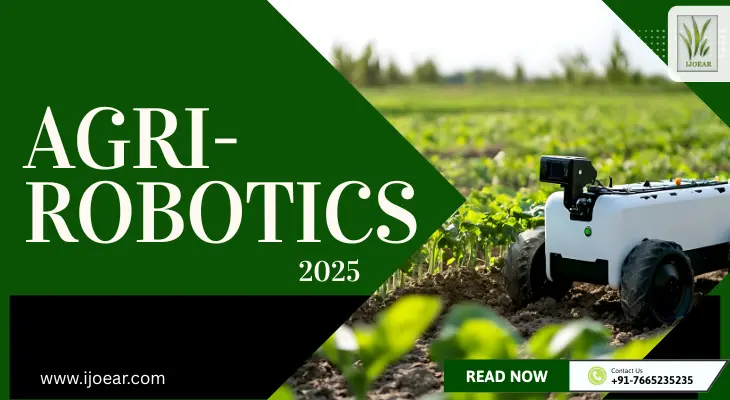
Agri-Robotics represents the convergence of robotics, artificial intelligence (AI), and precision agriculture, marking one of the most significant technological shifts in farming. With global food demands increasing under the twin pressures of climate uncertainty and labor shortages, farming systems are being compelled to transform rapidly. Autonomous machines—once restricted to factory floors—are now entering open-field agriculture, promising smarter, more efficient, and sustainable farming practices.
Unlike traditional mechanization, Agri-Robotics incorporates perception, reasoning, and adaptability. These robotic systems are designed to recognize environments, make decisions independently, and dynamically adjust to heterogeneity in soil conditions, crop types, and environmental factors. For researchers, engineers, and policymakers, Agri-Robotics offers a rich, multidisciplinary field with vast real-world applications.
The history of agricultural automation dates back to the 19th and early 20th centuries, with the introduction of steam power and diesel tractors. The Green Revolution of the 1960s–70s further accelerated mechanization, though these technologies were largely static—lacking adaptability and intelligence.
The 21st-century digital revolution ushered in autonomous capabilities, enabling machines to combine physical labor with decision-making. GPS-guided tractors, sprayers, and harvesters of the early 2000s offered limited autonomy, but today’s systems leverage AI, computer vision, and robotic grippers to diagnose diseases, measure fruit ripeness, and navigate fields independently.
Agri-Robotics combines diverse technologies to function in dynamic, uncertain agricultural environments:
Each of these domains represents fertile ground for research, especially as scientists attempt to apply theoretical AI and robotics frameworks to the complex, unpredictable conditions of agriculture.
The deployment of autonomous machinery is rapidly expanding across both open-field farming and controlled-environment agriculture (CEA).
AI-powered robots, such as Ecorobotix and Naïo, use machine vision to differentiate between weeds and crops. By applying microdoses of herbicides or mechanical removal, they drastically reduce chemical use—supporting sustainability targets like the EU Green Deal.
Harvesting remains one of the most labor-intensive processes in agriculture. Robots with soft-touch end effectors and real-time vision systems are being tested for strawberries, apples, and tomatoes. Platforms like SWEEPER (EU) and FFRobotics combine robotic picking with yield estimation and grading, improving both efficiency and quality.
Companies such as John Deere, Kubota, and CNH Industrial market autonomous tractors equipped with LiDAR, cameras, and AI. These machines can plow, sow, and haul independently or in fleets, coordinated by digital farm management platforms.
Drones equipped with NDVI and thermal sensors are revolutionizing crop monitoring, disease detection, and yield forecasting. They also support aerial spraying, seeding for reforestation, and regenerative agriculture practices.
Robotics in vertical farms and greenhouses automate seeding, transplanting, monitoring, and climate control. These controlled spaces serve as testbeds for developing precision robotics before scaling into open fields.
Despite major progress, Agri-Robotics faces several scientific, engineering, and social challenges:
Unpredictable outdoor conditions—dust, light variation, leaf occlusion, soil differences—limit sensor reliability. Systems must generalize across different geographies, crops, and seasons.
Most robots are crop-specific, limiting scalability. Future systems must adapt tasks across crops using meta-learning and lifelong learning architectures.
As collaborative robots (cobots) enter farm settings, ensuring worker safety through ergonomic design, predictive motion, and fail-safe systems is essential.
Battery charging and fuel refills remain a challenge in remote areas. Research is exploring solar-powered and hybrid energy solutions with minimal idle energy consumption.
The absence of shared communication protocols and data standards risks fragmenting the industry. Standardization initiatives are urgently needed to ensure integration and scalability.
The development of Agri-Robotics extends beyond technology into broader social and economic landscapes:
While reducing demand for seasonal labor, robotics creates new employment opportunities in mechatronics, robotics maintenance, and data science. Governments and universities must support reskilling initiatives to prepare the workforce.
High upfront costs risk excluding smallholder farmers in low- and middle-income countries. Innovative models like cooperative ownership, leasing, or Robot-as-a-Service (RaaS) can bridge this gap.
With robots collecting large volumes of farm-level data, questions of ownership, usage, and governance emerge. Policies must address how data is shared with manufacturers, insurers, or governments.
Robotics reduces chemical inputs and supports soil health through no-till farming, but a full lifecycle environmental assessment (production to disposal) is essential to ensure true sustainability.
The coming decade will witness significant advancements in Agri-Robotics:
International collaborations, open-source platforms, and government-backed research programs will play a pivotal role in advancing these innovations.
Agri-Robotics is not just an engineering breakthrough—it is reshaping how we grow, manage, and distribute food. From AI-driven weeding robots to drone-based disease monitoring, these innovations are addressing the critical challenges of labor shortages, climate change, and food security.
For researchers, Agri-Robotics offers multidisciplinary opportunities across AI, robotics, agronomy, and policy studies. For farmers, it represents a pathway toward efficiency and sustainability. The journey ahead requires collaboration between scientists, engineers, policymakers, and farmers to ensure that the benefits of automation are inclusive, ethical, and environmentally responsible.
Ques. 1: How do Agri-Robots differ from traditional machinery?
Ans.: Unlike traditional machines that follow predefined paths, Agri-Robots use sensors, AI, and real-time decision-making to adapt to varying field conditions.
Ques. 2: Are Agri-Robots suitable for small farms?
Ans.: Currently, most systems target industrial farms due to cost. However, modular, service-based, and leasing options are emerging to make them accessible to smallholders.
Ques. 3: What software tools are used in Agri-Robotics research?
Ans.: Common tools include Python, C++, MATLAB, ROS, OpenCV, TensorFlow, and Gazebo for development and simulation.
Ques. 4: What ethical concerns arise with Agri-Robotics?
Ans.: Issues include job displacement, algorithmic bias, environmental impact, and data governance, requiring collaboration among ethicists, engineers, and policymakers.
Ques. 5: Which crops are currently most compatible with Agri-Robotics?
Ans.: High-value crops like strawberries, tomatoes, apples, and grapes are early adopters due to profitability and market demand.
Ques. 6: How much do Agri-Robots cost, and are leasing options available?
Ans.: Costs range from tens of thousands to over a million USD, depending on system complexity. Leasing and Robot-as-a-Service (RaaS) models are expanding globally to improve affordability.
Ques. 7: How can graduate students contribute to Agri-Robotics?
Ans.: Students can engage through agricultural engineering programs, robotics competitions (e.g., Field Robot Event), AgriTech internships, and interdisciplinary Ph.D. research projects.
 NAAS Rating: 4.23
NAAS Rating: 4.23  October 2025 Issue
October 2025 Issue  Impact Factor: 6.69
Impact Factor: 6.69  Submit Article
Submit Article 
|
Citation Indices
|
All
|
Since 2020
|
|
Citation
|
6164
|
5117
|
|
h-index
|
31
|
29
|
|
i10-index
|
201
|
165
|
|
Acceptance Rate (By Year)
|
|
|
Year
|
Percentage
|
|
2024
|
11.09%
|
|
2023
|
15.23%
|
|
2022
|
12.81%
|
|
2021
|
10.45%
|
|
2020
|
9.6%
|
|
2019
|
14.3%
|
|
2018
|
17.65%
|
|
2017
|
16.9%
|
|
2016
|
22.9%
|
|
2015
|
26.1%
|